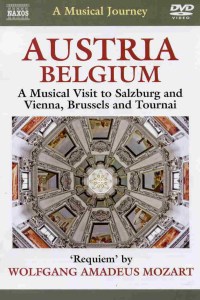 |
 |
|


alternatively
MDT
AmazonUK
AmazonUS
|
A Musical Journey - Austria and Belgium
A Musical Visit to Salzburg, Vienna, Brussels and Tournai
Chapter 1. Salzburg, Parish Church of St Peter. Mozartplatz. Cathedral
Chapter 2. Vienna, Army Museum
Chapter 3. Vienna, Central Cemetery. Karl Luger Memorial Church.
Army Museum
Chapter 4. Salzkammergut. Dachstein Glacier and Landscape
Chapter 5. Wachau: Fortified Church of St Michael in the Wachau
Valley. Belgium: Musee Wiertz, Brussels; Musee des Beaux-Arts,
Tournai
Chapter 6. Vienna, Town Views. Salzburg: Church of St Peter
Chapter 7. Vienna, Town Hall and Karlskirche. Salzburg. Collegiate
Church. Mozart on his Death-Bed
Chapter 8. Gottweig, Abbey Church
Chapter 9. Vienna, Composer's Monuments and History Museum
Chapters 10-11. Linz: Cathedral
Chapter 12. Salzkammergut, Wolfgangsee and Schafberg. Landscape
Chapter 13. Vienna, National Library. Salzburg, St Sebastian Cemetery
and Cathedral
Music. Mozart The Requiem Mass K626 (1791)
Magdelena Hajossyova (soprano); Jaroslava Horska (contralto); Jozef
Kundlak (tenor); Peter Mikulas (bass); Vladimir Ruso (organ)
Slovak Philharmonic Orchestra and Chorus/Zdenek Kosler from Naxos
CD 8.550235
No recording dates or venues given
DVD Director: G Gachot
Cameraman: H T Aschwanden
Audio Format: DTS 5.1. Dolby Digital 5.1. PCM Stereo 2.0
Video Format: NTSC. Region 0. Colour. Aspect ratio 4:3
 NAXOS
NAXOS  2.110333 [57.09]
2.110333 [57.09]
|
|
|
This visit is mainly concerned with Mozart’s birthplace, Salzburg, and
with Vienna, where he lived for the last decade of his all too
brief life. The music chosen is his Requiem K626. It
claims to relate to the life of the composer from his native
Salzburg to his final financially precarious existence in Vienna.
The commission for this work came anonymously as the composer
was completing Die Zauberflöte. The commission was
from Count Franz Walsegg who it is believed wished to pass it
off as his own. In fact Mozart died before completing it. Desperately
in need of money, and in order to obtain the second part of
the due payment, his widow passed the incomplete manuscript
to first Joseph Eybler and then to Mozart’s pupil Süssmayer
for completion.
This musical visit should, I suggest, be mainly concerned with
the sights Mozart would have known or which are associated with
him, albeit there is a major diversion to Belgium. Each section
of the mass is associated with different Chapters. The more
than usual notes indicate which parts of the music were composed
wholly by Mozart and those wholly or partly by Süssmayer.
This information is drawn from notes which Mozart left at his
premature death.
Whilst the content has some focus on Salzburg, where Mozart
was born, and Vienna where he moved to try to make an independent
living away from the influence of the church, there are many
diversions and irrelevances as far as the composer is concerned.
Certainly we see the churches associated with Mozart in Salzburg
(CHs.1, 6 and 7) and less so in Vienna, particularly their interior
features alongside external architecture. However there is a
failure to put them in the overall locale of the cities concerned
with only occasional general views of the associated impressive
rivers. Of interest would have been photographs of the venues
of the Salzburg festivals. The concern with church features
is somewhat excessive and extends to the diversion to Belgium,
which, as far as I am aware, has no claim even to a Mozart visit
(CH.5).
The views of the photographically impressive Dachstein glacier
(CH.4) become a welcome diversion from a preoccupation with
churches that extends to Linz (CHs. 10-11). Also impressive,
photographically, are the night scenes in Vienna and the views
of the neo-Gothic Town Hall erected during the reign of Emperor
Franz Joseph I (CH.7). Vaguely more relevant to Mozart is the
Central Cemetery in Vienna, opened in 1898, where there is a
monument to him. Beethoven, Schubert, Brahms and Gluck are buried
here along with other distinguished composers. The main avenue
leads to the Karl Luger Memorial Church (CH.3). CH.9 focuses
on the monuments in the formal Burggarten in Vienna (the former
Kaisergarten), laid out between 1817 and 1824 and which includes
a memorial to Mozart and a monument to Goethe with Schiller
commemorated nearby. The Vienna History Museum is among institutions
holding material depicting some of the great composers who lived
in Vienna, including Mozart, Schubert and Bruckner. A painting
of Mozart by Saveno dalla Rosa made in 1770 in Verona at the
age of fourteen is among various portraits of the composer including
a depiction of a deathbed scene.
The musical performance is more than adequate with a clear soaring
soprano, a baritonal tenor (CH.2) and a sonorous bass and contralto
(CH.7).The whole is conducted with a good sense of style by
Zdenek Kosler.
This DVD lacks the clear focus of a previous issue that I commended
with a different director (see review).
Maybe some of these issues depend very much on existing photography
when a clearer focus on objectives would be more appropriate,
especially as the word ‘travelogue’ is used.
Robert J Farr
|
|

